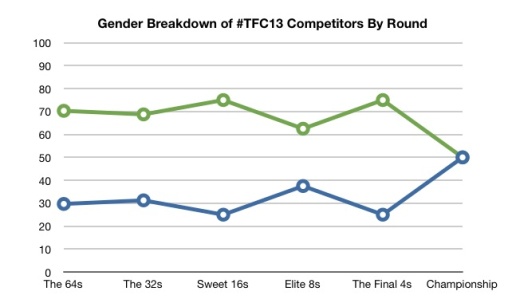[Note: If you want to understand this post at all and are new to Twitter Fight Club, I strongly recommend you read this FAQ post by Hayes Brown and also follow him @HayesBrown]
I’ve never gotten super into basketball, and my beloved UMass Lowell Riverhawks lost in the Elite 8 in hockey this year (*wipes tears*), so all of my March Madness energy has been channeled into a quirky competition known as Twitter Fight Club. I even had the opportunity to judge a round this year, an opportunity that @PTSDInfo wrote about in the Huffington Post. You can read my scathing reviews of the great minds of National Security here.
Kelsey (@AthertonKD) is competing in the finals today against our dear friend Daveed (@DaveedGR), which sparked a conversation at home for us about gender representation in NatSec Twitter. We thought it would be interesting to take a look at gender in Twitter Fight Club since its 2011 inaugural season. Since Kelsey had his big fight today, and I’m usually the one who does gender (get it?), I volunteered to do the dirtydata work.
Before I dive in, I also want to say a note about language. I chose to use the terms “woman” and “man” because I don’t really care so much about biological sex, but the gender perceived by third parties. I wasn’t going to be asking anyone point blank about their gender for two reasons: a) because that’s rude to do to strangers and b) if I can’t perceive their gender, other competitors probably can’t perceive their gender, and therefore, it’s probably not affecting the overall gender climate of the competition.
To be honest, I think gender looks a lot more like this, but I wasn’t going to be able to ask all 64 competitors from every year to draw themselves as a gingerbread person, so here we are.
My methods were this: I found lists of every competitor of every TFC match, and did research (through Twitter or asking one of my trusted sources who may know them offline) if they knew their gender off hand. If my immediate searches were gender-less, I did not include them in the results one way or the other. I assigned perceived women with a 1, and perceived men with a 0, because that’s a fun excel trick to make averages super easy. It wasn’t a political statement, I swear.
I repeated these steps for each match, and then made a graph showing the percentages of competitors by gender for each year.
Here’s #TFC14.
Started with a gender disparity, got a little worse, then there was a 50/50 split, and then back to the patriarchy an all-male championship.
Then this was last year, the year when a woman (@TexasInAfrica) won it all:
In 2012, things were a little worse…
But the first year had the worst gender diversity of all.
The bottom line is this: I think things are getting better for the women of NatSec Twitter, but there is still some room for improvement.
I opted not to put my individual spreadsheets up because I didn’t want to have mis-gendered someone that I couldn’t have confirmed with someone or something, or have someone wonder why theirs was left off if I was unable to Gender ID them. If you have any questions about it, I’m happy to talk over email, especially if it’s about your own status in our data. If you want me to republish stats with new info- also happy to do that.
Some shortcomings for this afternoon project? I can’t stress enough, this was a pretty cisgender-focused lens. If folks don’t identify as one gender binary over another, that was not represented because we went by genders represented on social media as perceived by third parties, not necessarily self-ID’d gender. Competitors also did not ID themselves when I sent out a blanket ask to everyone… well…correction: only one person (publicly) ID’d themselves, but it was not in any gender scale my training in gender studies has taught me:
https://twitter.com/brettfriedman/status/451367310708969472
Some DMs allowed clarification to what gender this individual wanted to be represented as for statistical purposes.
There’s a lot more that can be done with gender and TFC data (I keep coming up with ideas!), but this was the place to start. I want to give a special thanks to @AthertonKD for being a collaborator for this project, all while fighting a #1 seed for the title and taking care of me while I’m sick, and also to @caidid and @AnniesPerson for help and pointers along the way.
❤ @Alymaybe
PS- I always try to add visual accessibility brackets to my photos, but I wasn’t sure how to best do that with a graph. If you need accommodations, please email me at Alymay.Sellars@gmail.com and I’ll try my best to do what I can! Also if you have tips for the future, I’d love to hear them!
























